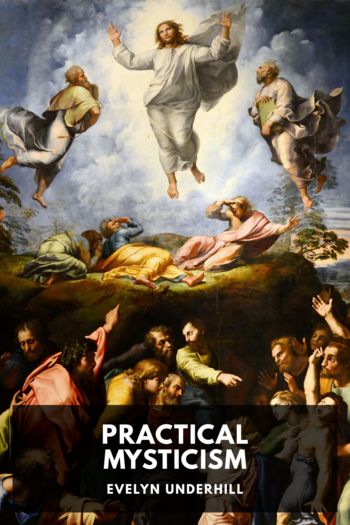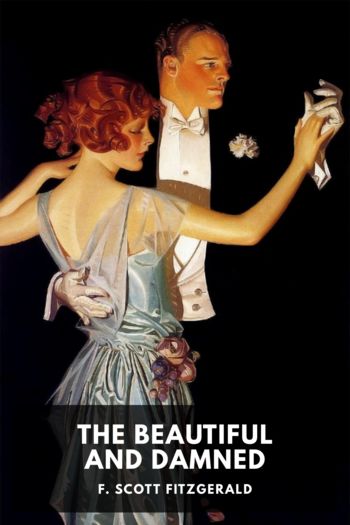Practical Mysticism by Evelyn Underhill (classic reads .txt) 📕

- Author: Evelyn Underhill
Book online «Practical Mysticism by Evelyn Underhill (classic reads .txt) 📕». Author Evelyn Underhill
Since the philosopher’s interests are mainly objective, and the artist seldom cogitates on his own processes, it is, in the end, to the initiate of religion that we are forced to go, if we would learn how to undertake this training for ourselves. The religious contemplative has this further attraction for us: that he is by nature a missionary as well. The vision which he has achieved is the vision of an intensely loving heart; and love, which cannot keep itself to itself, urges him to tell the news as widely and as clearly as he may. In his works, he is ever trying to reveal the secret of his own deeper life and wider vision, and to help his fellow men to share it: hence he provides the clearest, most orderly, most practical teachings on the art of contemplation that we are likely to find. True, our purpose in attempting this art may seem to us very different from his: though if we carry out the principles involved to their last term, we shall probably find that they have brought us to the place at which he aimed from the first. But the method, in its earlier stages, must be the same; whether we call the Reality which is the object of our quest aesthetic, cosmic, or divine. The athlete must develop much the same muscles, endure much the same discipline, whatever be the game he means to play.
So we will go straight to St. Teresa, and inquire of her what was the method by which she taught her daughters to gather themselves together, to capture and hold the attitude most favourable to communion with the spiritual world. She tells us—and here she accords with the great tradition of the Christian contemplatives, a tradition which was evolved under the pressure of long experience—that the process is a gradual one. The method to be employed is a slow, patient training of material which the licence of years has made intractable; not the sudden easy turning of the mind in a new direction, that it may minister to a new fancy for “the mystical view of things.” Recollection begins, she says, in the deliberate and regular practice of meditation; a perfectly natural form of mental exercise, though at first a hard one.
Now meditation is a halfway house between thinking and contemplating: and as a discipline, it derives its chief value from this transitional character. The real mystical life, which is the truly practical life, begins at the beginning; not with supernatural acts and ecstatic apprehensions, but with the normal faculties of the normal man. “I do not require of you,” says Teresa to her pupils in meditation, “to form great and curious considerations in your understanding: I require of you no more than to look.”
It might be thought that such looking at the spiritual world, simply, intensely, without cleverness—such an opening of the Eye of Eternity—was the essence of contemplation itself: and indeed one of the best definitions has described that art as a “loving sight,” a “peering into Heaven with the ghostly eye.” But the self who is yet at this early stage of the pathway to Reality is not asked to look at anything new, to peer into the deeps of things: only to gaze with a new and cleansed vision on the ordinary intellectual images, the labels and the formula, the “objects” and ideas—even the external symbols—amongst which it has always dwelt. It is not yet advanced to the seeing of fresh landscapes: it is only able to reexamine the furniture of its home, and obtain from this exercise a skill, and a control of the attention, which shall afterwards be applied to greater purposes. Its task is here to consider that furniture, as the Victorines called this preliminary training: to take, that is, a more starry view of it: standing back from the whirl of the Earth, and observing the process of things.
Take, then, an idea, an object, from amongst the common stock, and hold it before your mind. The selection is large enough: all sentient beings may find subjects of meditation to their taste, for there lies a universal behind every particular of thought, however concrete it may appear, and within the most rational propositions the meditative eye may glimpse a dream.
“Reason has moons, but moons not hers,
Lie mirror’d on her sea,
Confounding her astronomers,
But, O delighting me.”
Even those objects which minister to our sense-life may well be used to nourish our spirits too. Who has not watched the intent meditations of a comfortable cat brooding upon the Absolute Mouse? You, if you have a philosophic twist, may transcend such relative views of Reality, and try to meditate on Time, Succession, even Being itself: or again on human intercourse, birth, growth, and death, on a flower, a river, the various tapestries of the sky. Even your own emotional life will provide you with the ideas of love, joy, peace, mercy, conflict, desire. You may range, with Kant, from the stars to the moral law. If your turn be to religion, the richest and most evocative of fields is open to your choice: from the plaster image to the mysteries of Faith.
But, the choice made, it must be held and defended during the time of meditation against all invasions from





Comments (0)